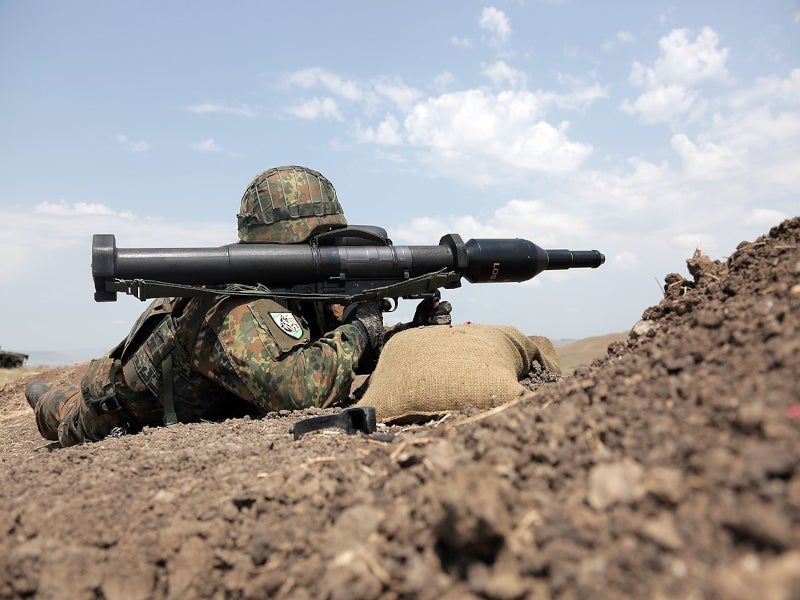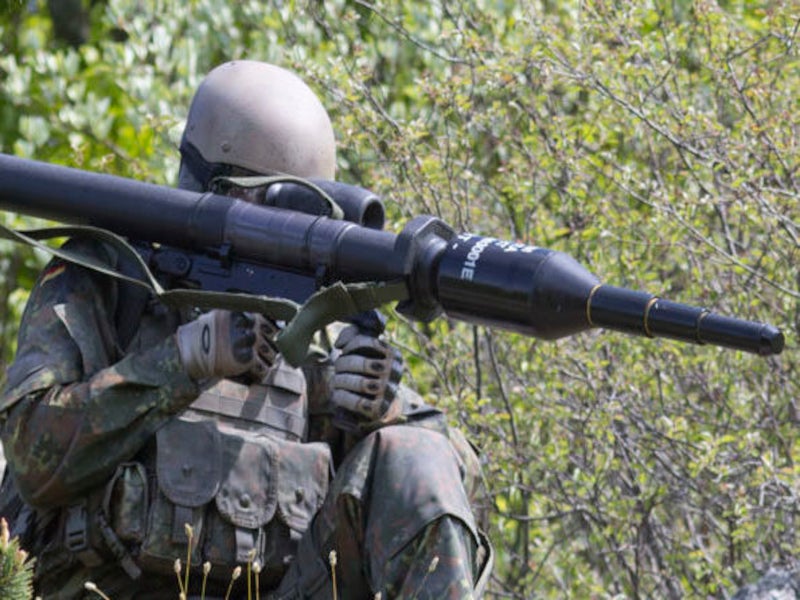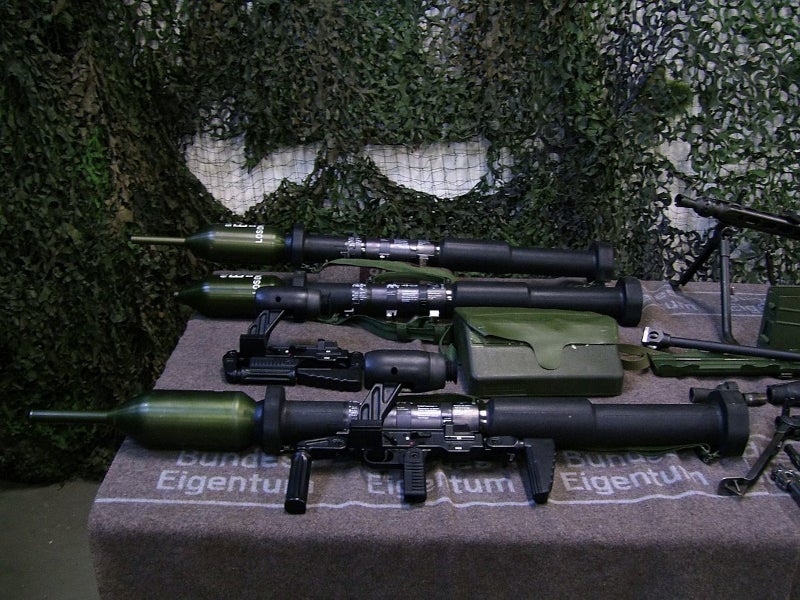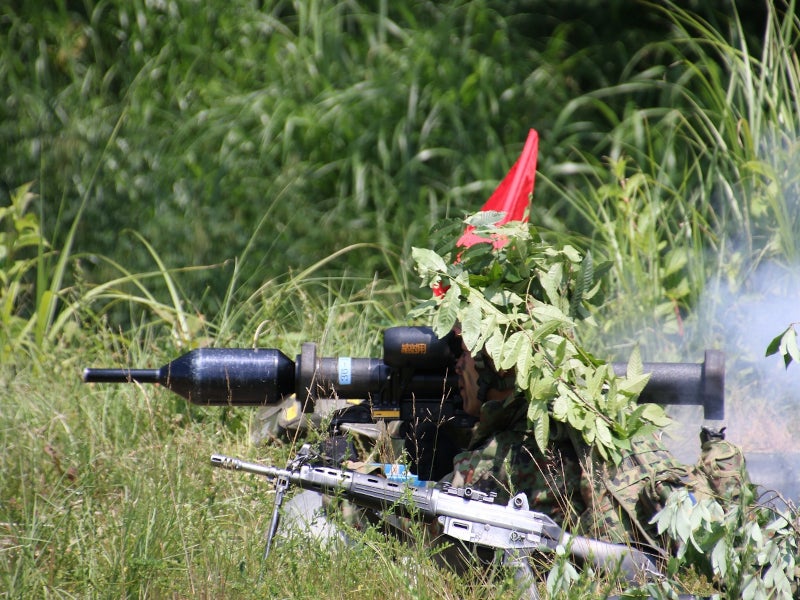The Panzerfaust 3 (Pzf 3) is a man-portable, disposable, recoilless, anti-tank weapon manufactured by Dynamit Nobel Defence, a German weapons company and a subsidiary of Israel’s Rafael Advanced Defense Systems.
It is a shoulder-launched anti-tank weapon designed to destroy a wide spectrum of targets on the battlefield, including vehicles such as modern battle tanks, infantry fighting vehicles and armoured combat vehicles, and structures such as bunkers, fortifications, buildings and other military infrastructure.
The development of the Pzf 3 anti-tank weapon began in 1978 to replace its previous version, Panzerfaust 2, which was incapable of penetrating the armour of the Soviet T-72 and T-80 main battle tanks.
The Pzf 3 entered service with the armed forces of Germany (Bundeswehr) in 1987, following the completion of development in 1985. It is currently in service with several countries including Germany, Japan, the Netherlands, Switzerland, Belgium, Peru, Italy, South Korea, Iraq and Ukraine.
In February 2022, the Netherlands announced the supply of 50 Pzf-3 anti-tank weapons to Ukraine. The package also includes 400 rocket-propelled grenades and 200 Stinger air-defence missiles.
Design and features
The Pzf 3 anti-tank weapon has a length of 1,200mm and a weight of 13kg. It is an unguided portable launcher of anti-tank missile and rocket systems, primarily used against armoured targets. It is used with different types of cartridges for required action on different types of targets and can be fired from vehicles and closed rooms.
The weapon system comprises two basic parts, a 110mm calibre warhead pre-loaded into a disposable canister, and a reusable fire control and sighting unit.
The warhead is attached to the fire control and sighting unit before firing. Several types of rounds are available for the weapon differing in the warhead types.
The weapon uses the Davis cannon principle to kill the recoil force generated by it during launch, allowing it to be launched from a limited volume space, using an over-calibre projectile attached to the front part of the launching tube.
A countermass equal to the weight of the projectile is ejected from the rear end of the tube to diminish the recoil force.
The designers decreased the projectile’s muzzle velocity to 165m/s to reduce the weapon weight as well as the flash, smoke and sound generated when a round is fired. The rocket booster ignites once the projectile is at safe distance from the operator, and further accelerates the projectile.
The weapon provides the ability to fire a 110mm calibre projectile from the 60mm calibre launcher. An extensible probe in the warhead enables enhanced armour penetration.
Mission capabilities
The weapon serves as a bazooka when loaded with shaped-charge ammunition to penetrate an armoured target with an armour thickness of 700mm.
The Bunker Fist (Bunkerfaust) configuration of the weapon is equipped with a different ammunition to fire against targets behind cover and in bunkers. It can penetrate reinforced concrete up to 240mm.
The weapon can be operated by a single soldier to hit a moving target at a maximum range of 300m and a stationary target at up to 400m.
Ammunition and warhead
The Pzf 3 projectile was initially equipped with the shaped-charge high-explosive anti-tank HEAT warhead with armour penetration of about 40cm.
Dynamit Nobel Defence developed the Pzf 3-T version, which features a tandem warhead capable of destroying reactive armour and penetrating about 70cm of steel armour.
Pzf 3-Improved Tandem (IT), an improved version of the hand-held anti-tank weapon, features a retractable nose rod with front charge. It was developed with an improved dual-mode (HEAT and high-explosive squash head (HESH)) tandem warhead to defeat reactive armour.
The cartridges of the weapon were also upgraded from the initial DM12 with a shaped-charge warhead to the DM22 with double shaped-charge warhead and the high explosive anti-tank-improved tandem-rocket assisted (HEAT-IT-RA) DM72 for enhanced performance. The DM72A1 was later introduced for the Pzf 3-IT, the most modern version of the bazooka.
The Pzf 3-IT DM72A1 cartridge can penetrate armour steel when fired in HEAT mode and work as a squash-nose bullet in HESH mode.
The Bunker fist projectile uses a follow-through fragmentation warhead. Munition types of Pzf 3 also include multipurpose fragmentation, illumination, smoke, and infrared (IR) smoke.
Fire control and sighting unit
The fire control unit features a mechanical trigger and manual safety. The reusable firing device can be mounted with an optical sight and installed with sighting equipment.
Dynarange, the latest version of the fire control unit, enables the operators to hit targets at an increased range of up to 600m.
The 3-T version is equipped with the Simrad IS200 laser and the Simrad KN205F II night sight.
The 3-T600 features the Simrad IS2000 laser gun sight with a range of 600m for moving targets. It can also be installed with the Simrad KN205F night sights for night combat capabilities.
Variants
The weapon comes in the Pzf 3 standard anti-tank version, Pzf 3 Bunkerfaust, and advanced versions such as Pzf 3-T600, Pzf 3-T, Pzf 3-T600, Pzf 3-IT600, Pzf 3-LTW and Pzf 3LR.
The Pzf3-LTW system weighs less than 10kg. The Pzf 3LR, which is a long-range semi-active laser homing (SALH) system, has a range of 800m and an armour penetration capability of 700mm.
Pzf 3 anti-tank weapon orders and deliveries
The first export contract for the Pzf 3 anti-tank weapon was signed with Japan in 1989.
Dynamit Nobel Defence received a contract from German defence procurement agency BAAINBw to deliver 3,000 rockets for the Pzf 3-IT anti-tank weapon system of the German armed forces in February 2021.
The company received another contract to deliver 3,500 DM72A1 cartridges for the German armed forces’ Pzf 3-IT system in July 2022.





